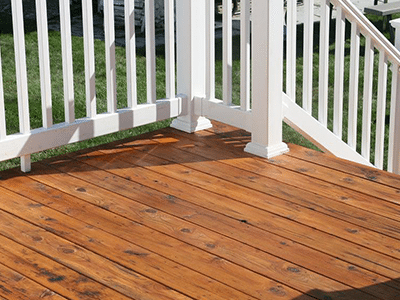Revitalize Your Outdoors: Professional Deck Staining Providers
Wiki Article
Choosing the Right Discoloration for Your Fence: Tips and Factors To Consider
When it comes to boosting the look and maintaining of your fence, selecting the appropriate stain is important. We will certainly discover the different kinds of fencing discolorations, variables to consider prior to selecting a stain, pointers for preparing your fence for staining, and the differences between oil-based and water-based spots. In addition, we will delve into choosing the right stain color to complement your fence and enhance your outdoor room.Recognizing Different Types of Fencing Discolorations
:max_bytes(150000):strip_icc()/Wooddeckpaintstain-GettyImages-155145295-597560af054ad90010f80913.jpg)
On the various other hand, water-based discolorations are made from acrylic or latex and offer a more subtle color to the wood. Water-based discolorations are easier to clean up and have a quicker drying time compared to oil-based spots.
Selecting in between water-based and oil-based discolorations depends on different variables, consisting of individual choice, the wanted look, and the degree of upkeep called for. Oil-based discolorations are advised for fencings in high-traffic locations or those constantly subjected to extreme weather. fence staining and sealing. Water-based discolorations, on the other hand, are a popular choice for surround domestic areas where look and ease of use are necessary
When picking the right stain for their fencing,Comprehending the distinctions in between water-based and oil-based discolorations assists house owners make a notified choice. Thinking about the particular needs of the fencing, such as its place, exposure to sunlight, and wanted visual, will ensure that the picked stain provides long-lasting security and enhances the total charm of the fence.
Factors to Take Into Consideration Before Picking a Spot

Various types of timber take in stains in different ways, resulting in differing degrees of color strength and durability. In addition, certain timbers might be much more vulnerable to problems like rot or insect problem, which may impact the selection of stain to maintain the fence and secure.
The climate and climate condition in your location should also be taken into account. You may require a tarnish that supplies additional protection against dampness and UV rays if you live in an area with rough winter seasons or high humidity. If your fencing is subjected to guide sunlight for long periods, a stain with UV preventions can aid protect against fading and staining.
Last but not least, it is essential to consider your wanted aesthetic. Different stains provide various shades and coatings, enabling you to personalize the appearance of your fencing (deck staining). Think about the general style and design of your property, along with any kind of regional policies or homeowner association standards that might dictate the appropriate discolor colors
Tips for Readying Your Fence for Staining
To prepare your fencing for staining, beginning by extensively cleaning the surface area utilizing a mild cleaning agent and company website a stress washer or scrub brush. Cleansing the fencing is an essential step as it gets rid of dust, grime, and any kind of previous layers that might hinder the discoloration process. Begin by moistening the fence with water and afterwards apply a light detergent using a scrub brush or a stress washing machine with a low-pressure setting. Scrub the surface area gently, paying added attention to locations with stubborn stains or mold and mildew. Rinse the fencing thoroughly with tidy water to remove all traces of cleaning agent.After cleaning, allow the fencing to dry entirely. fence staining. This action is critical as staining a moist or damp surface can bring about poor bond and an unequal coating. Depending upon the weather problems, it might take anywhere from a couple of hours to a few days for the fencing to dry thoroughly. Ensure that the fencing is completely dry prior to continuing with the discoloration procedure.
Prior to discoloration, check the fencing for any kind of problems, such as loose boards or nails. This product helps to open up the wood pores, permitting the discolor to permeate much more efficiently and evenly.

Comparing Water-Based and oil-based Discolorations
When choosing a discolor for your fence, it is crucial to compare the qualities and advantages of oil-based and water-based spots. Both sorts of discolorations have their own advantages and factors to consider, so it is essential to recognize the distinctions between them.Oil-based discolorations are understood for their durability and resistance to tear and put on. They pass through deeply into the timber, providing exceptional defense against the components. They likewise improve the natural charm of the timber by highlighting its grain and texture. Additionally, oil-based discolorations tend to last longer than water-based stains, making them a prominent option for fencings.
On the other hand, water-based stains are more ecologically friendly and much easier to cleanse up. They might not supply the same level of security as oil-based stains, especially in rough weather condition conditions.
Ultimately, the selection between oil-based and water-based stains relies on your certain needs and choices. Take into consideration elements such as sturdiness, environmental influence, and simplicity of application when making your choice. Consulting with a specialist or seeking referrals from specialists can likewise assist guarantee that you choose the right stain for your fencing.
Choosing the Right Discoloration Color for Your Fence
The option of a suitable tarnish color for your fencing is a vital element of enhancing its aesthetic allure and matching the overall style of your exterior space (fence staining and sealing). The right tarnish color can transform a level, common fencing right into a striking focal factor that includes depth and personality to your residential propertyWhen selecting a tarnish color for your fencing, it is very important to think about the design and design of your home. If you have a traditional or timeless style home, earthy tones such as browns and neutrals can produce a cozy and inviting appearance. On the other hand, if you have a modern-day or contemporary home, you may consider going with bold and lively shades that make a statement.
One more variable to consider is the natural environments of your building. If you have a great deal of greenery, a discolor shade that complements the natural landscape, such as eco-friendlies or crimsons, can create a harmonious and cohesive appearance.
Furthermore, it deserves taking into consideration the maintenance required for different discolor shades. Lighter shades often tend to show dust and put on even more quickly, while darker shades can hide flaws and call for much less constant touch-ups.
Ultimately, the selection of stain color for your fencing need to reflect your personal style and preferences - fence cleaning. Make the effort to get in touch with and explore various alternatives with professionals if needed, to make certain that you select the ideal tarnish shade that enhances the charm and charm of your fencing
Verdict
To conclude, when it pertains to picking the ideal stain for your fence, it is necessary to comprehend the various kinds of discolorations available and take into consideration factors such as toughness and wanted look. Preparing the fencing properly before staining is important for accomplishing ideal results. Furthermore, contrasting water-based and oil-based discolorations can aid establish the most effective alternative for your details demands. Lastly, selecting the right tarnish shade can boost the overall appearances of your fencing.We will certainly check out the different kinds of fence stains, variables to think about before picking a discolor, suggestions for preparing your fencing for discoloration, and the distinctions in between oil-based and water-based stains.Distinguishing in between water-based and oil-based stains is crucial when recognizing different kinds of fence discolorations. Water-based discolorations are simpler to cleanse up and have a quicker drying out time compared to oil-based stains. In addition, oil-based stains often tend to last longer than water-based stains, making them a preferred choice for fencings.
In verdict, when it comes to choosing the ideal stain for your fencing, it is important to comprehend the various types of stains readily available and take into consideration aspects such as longevity and wanted appearance.
Report this wiki page